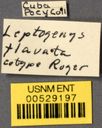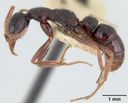Leptogenys
Leptogenys
Classification
- Phylum: Arthropoda
- Subphylum: Hexapoda
- Class: Insecta
- Order: Hymenoptera
- Superfamily: Formicoidea
- Family: Formicidae
- Subfamily: Ponerinae
- Tribe: Ponerini
- Genus: Leptogenys
Pronunciation
How to pronounce Leptogenys: /ˌlɛp.toˈd͡ʒɛ.nɪs/
These audio files are automatically generated. While they are not always 100% accurate, they are a good starting point.
Images






Summary
Leptogenys is a highly diverse genus of ponerine ants, known for their diverse social structures, behaviors, and ecological roles. It includes over 260 extant species, primarily found in tropical and subtropical regions.
Physical Characteristics
Workers can be distinguished by the distinct pectinate ventral margin of the tarsal claws. Most have falcate, bowed mandibles and exhibit a range of eye sizes depending on their habitat.
Identification Tips
Look for the unique pectinate ventral margin of tarsal claws and the presence of falcate mandibles.
Habitat
Found in tropical and subtropical regions, including leaf litter and soil layers. Some species are epigaeic, living primarily above ground, while others are cryptobiotic, inhabiting soil and litter.
Distribution
Widespread throughout tropical and subtropical regions. Two North American species are identified: Leptogenys elongata (Texas and Mexico) and Leptogenys manni (Florida).
Diet
Many species are specialists on isopod prey.
Life Cycle
Details on the specific life cycle of Leptogenys species are not provided, but typically includes a worker, ergatoid queen, and likely some variety in social organization.
Reproduction
Most species have ergatoid queens, reflecting a variety of reproductive strategies.
Ecosystem Role
Leptogenys ants play a significant role in the ecosystem as predators, particularly of isopod prey, and contribute to soil aeration and nutrient cycling.
Evolution
The taxonomic history includes various junior synonyms due to morphological diversity. Originally listed in a distinct tribe, Leptogenyini, later synonymized with Ponerini.
Similar Taxa
- Prionogenys
- Lobopelta
- Odontopelta
- Machaerogenys
- Dorylozelus
- Microbolbos
Tags
- Hymenoptera
- Formicidae
- Ponerinae
- ant genus
- tropical ants